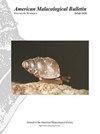AMS研讨会“软体动物系统基因组学”介绍,美国马六甲学会第82届年会
IF 0.4
4区 生物学
Q4 MARINE & FRESHWATER BIOLOGY
引用次数: 0
摘要
70如果你在NCBI核苷酸数据库中搜索“Mollusca”,并根据修改的日期对条目进行排序,那么列表中出现的第一个序列是一个119 bp的序列,来自1758年由Fang及其同事发表的蜗牛Helix pomatia Linnaeus的5.8S rRNA基因。从那时起,简单地说,软体动物的可用分子序列数据数量显著增加(在撰写本文时,仅NCBI核苷酸数据库中就有3371221个序列)。这种增长被DNA测序技术的进步所打断。我出生在5.8S序列上传的时候,我只见过劳动密集型变性聚丙烯酰胺尿素凝胶和用于生成它的放射自显影设备的废弃遗迹。2007年,当我开始博士论文研究时,我的第一章旨在通过PCR从cDNA中扩增核蛋白编码基因,并在毛细管测序仪上使用Sanger测序对其进行测序。我们进行了自己的毛细管测序,尽管我认为与运行测序凝胶相比,这是一件轻而易举的事,但每一次成功的反应都感觉像是个人的胜利。在我开始论文研究大约一年后,在我能够使用这种方法收集足够的数据来发表任何有价值的论文之前,Roche 454焦磷酸测序问世了,很明显,全面使用这种“尖端”技术会更快。在不到十年的时间里,我们目睹了罗氏454焦磷酸测序的兴衰,Illumina测序的普及率和能力飙升,人类基因组测序的成本下降了两个数量级(Muir等人,2016)。如今,有一些仪器可以在3天内产生比上述5.8S rRNA序列略长的约10亿个序列,价格约为1000美元(Illumina 2016)。最近高通量DNA测序技术的飞跃使研究非模式生物的单个实验室能够进行全基因组测序、对大量转录组进行测序、对富含感兴趣基因的DNA序列库进行靶向捕获方法等。高通量测序的这些令人兴奋的进展导致了许多涉及软体动物生物学各个方面的高收益论文(例如,Kocot等人2011,Smith等人20112013,Zhang等人2012,AMS研讨会“软体动物的系统基因组学”简介,82美国马六甲学会年会本文章由计算机程序翻译,如有差异,请以英文原文为准。
Introduction to the AMS Symposium “Phylogenomics of Mollusks,” 82nd Annual Meeting of the American Malacological Society
70 If you search the NCBI nucleotide database for “Mollusca” and sort the entries by date modifi ed, the fi rst sequence to appear in the list is a 119 bp sequence from the 5.8S rRNA gene from the snail Helix pomatia Linnaeus, 1758, which was published by Fang and colleagues in 1982. Since then there has been, to put it lightly, signifi cant growth in the amount of available molecular sequence data from molluscs (3,371,221 sequences in the NCBI nucleotide database alone at the time of writing this manuscript). This growth has been punctuated by advances in DNA sequencing technology. I was born around the time that 5.8S sequence was uploaded and I’ve only ever seen discarded relics of the labor-intensive denaturing polyacrylamide-urea gel and autoradiography equipment that were used to generate it. When I began my Ph.D. dissertation research in 2007, my fi rst chapter was aimed at amplifying nuclear protein-coding genes via PCR from cDNA and sequencing them using Sanger sequencing on a capillary sequencer. We performed our own capillary sequencing and, although I imagine it was a breeze compared to running sequencing gels, every successful reaction felt like a personal victory. About a year after starting my dissertation research and before I was able to collect enough data using this approach to have anything remotely worthy of a publication, Roche 454 pyrosequencing came out and it became clear that it would be faster to start all over using this “cutting-edge” technology. In less than ten years, we have watched Roche 454 pyrosequencing rise and fall, Illumina sequencing soar in popularity and capability, and the cost of sequencing a human genome drop two orders of magnitude (Muir et al. 2016). Today, there are instruments that can generate about one billion sequences slightly longer than the aforementioned 5.8S rRNA sequence in 3 days for about USD $1,000 (Illumina 2016). Recent leaps forward in high-throughput DNA sequencing technology have made it feasible for single laboratories working on non-model organisms to conduct whole genome sequencing, sequence numerous transcriptomes, conduct targetcapture approaches to sequence pools of DNA enriched for genes of interest, etc. These exciting advances in highthroughput sequencing have led to a number of high profi le papers dealing with diverse aspects molluscan biology (e.g., Kocot et al. 2011, Smith et al. 2011, 2013, Zhang et al. 2012, Introduction to the AMS symposium “Phylogenomics of Mollusks,” 82 annual meeting of the American Malacological Society
求助全文
通过发布文献求助,成功后即可免费获取论文全文。
去求助
来源期刊
CiteScore
1.00
自引率
40.00%
发文量
1
审稿时长
>12 weeks
期刊介绍:
The American Malacological Bulletin serves as an outlet for reporting notable contributions in malacological research. Manuscripts concerning any aspect of original, unpublished research,important short reports, and detailed reviews dealing with molluscs will be considered for publication. Recent issues have included AMS symposia, independent papers, research notes,and book reviews. All published research articles in this journal have undergone rigorous peer review, based on initial editor screening and anonymous reviewing by independent expertreferees. AMS symposium papers have undergone peer review by symposium organizer, symposium participants, and independent referees.

 求助内容:
求助内容: 应助结果提醒方式:
应助结果提醒方式:


